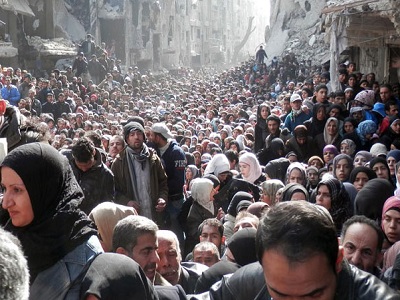
By Annie Slemrod
The UN has quietly added four areas to its increasingly controversial list of areas under siege in Syria, including Yarmouk and Madaya, the town that brought the issue of blockades into the limelight.
In a newly released map, OCHA Syria marked Madaya, Bqine, Yarmouk, and Madamiyet ElShams (also known as Moadamiyeh) as besieged, bringing the total number to 19. Neither OCHA’s previous map nor the most recent UN secretary-general’s report on the humanitarian situation in Syria classified these areas as under siege.
A representative for OCHA Syria confirmed that the four areas had been added to the UN’s besieged list, but did not respond to IRIN’s request for further details.
In a statement last week to the UN Security Council, UN humanitarian chief Stephen O’Brien also described Madaya as “besieged,” and said 486,700 Syrians were living under siege. This number is also reflected on OCHA’s new map, an increase from the previous count of 393,700.
According to Foreign Policy, which received an early draft of the UN’s Humanitarian Response Plan, 10 references to “sieged” or “besieged areas” were removed by the time it was published in late December. An OCHA spokeswoman told the magazine that it was standard practice to allow governments to consult on such plans.
And in July 2015, the UN quietly removed the Yarmouk Palestinian camp from its besieged list, although at the time it had not been able to deliver relief in four months. It has now been added once again, but no explanation has been given.
In early January, aid convoys were allowed inside Madaya – where residents were desperate, starving, and eating leaves — as well as the northern towns of Fua and Kefraya. The access was part of a deal between warring factions, as the same militant group inside Madaya surrounds Fua and Kefraya.
But there was no agreement on sustained humanitarian passage, and the medical charity Médecins Sans Frontières said Friday that 16 people had died inside Madaya since the delivery.
“It is totally unacceptable that people continue to die from starvation, and that critical medical cases remain in the town when they should have been evacuated weeks ago,” Brice de le Vingne, MSF’s director of operations, said in a statement.
Outrage is growing over the siege warfare tactics that have become commonplace in Syria, and Marianne Gasser, head of the International Committee of the Red Cross’ delegation Syria, wrote candidly for the BBC about her frustration with the difficulties in negotiating aid access.
The relief operation for Madaya took “months to negotiate”, Gasser writes, describing how the politics of war meant that aid trucks to Madaya were not allowed to continue on their journey until a truck carrying supplies to other besieged towns could be unstuck from the mud.
“No food could be delivered to one town until it was shown – via photos on WhatsApp – that the same food was being delivered to the other side,” she writes. “Aid by synchronisation. This is not the way to run relief operations.”
Aid organisations operating inside Syria need permission from the Syrian government to move, and the UN says that only 10 percent of its requests for inter-agency convoys in 2015 resulted in actual delivery. O’Brien has called the Syrian government’s approval rate “pitiful”.
These restrictions have led to calls for airdrops into Syria, although governments and some experts argue it isn’t feasible.
Peace talks about the Syria war, which has seen nearly 300,000 people killed, have been dogged by delays and threats of boycott. The main Syrian opposition group has arrived in Geneva, but they have made the lifting of blockades a major part of their platform and willingness to negotiate.




